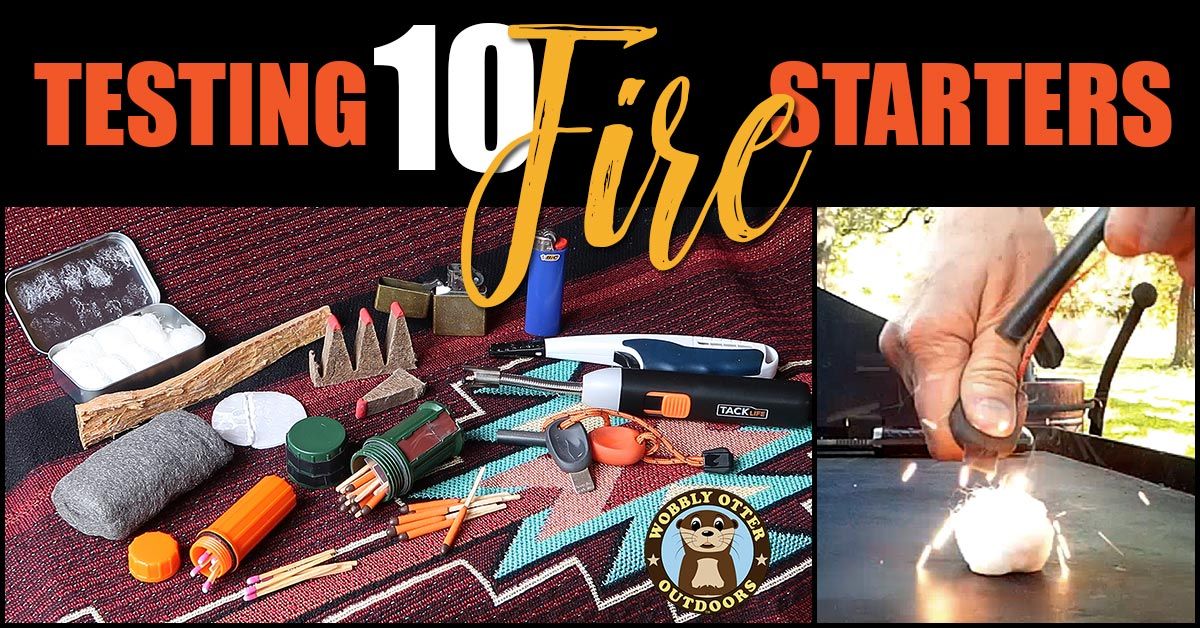Wobbly Otter Outdoors Videos
Testing 10 Fire Starting Methods
- Details
- Written by Cris
- Hits: 3802

We take a look at ten different items for fire starting that are in my go bag (camp pack) and see how each one works. After this video, some are not in my pack anymore, and there is one outright fail of an item that didn't even make the list.
In the video below, you'll see the ten fire starting methods tested. My favorites are the cotton balls coated with petroleum jelly and the storm matches.
Thank you for watching. We hope you'll subscribe to get the best Wobbly Otter adventures, how to's, and gear reviews delivered directly to you.
List Items Tested with Product Links
- Cotton balls coated with petroleum jelly
- Ferro Rod by Light My Fire: https://amzn.to/2H6AyX6
- A lighter - BIC: https://amzn.to/2ICHbh3 or Zippo: https://amzn.to/2Jvb5oS
- Cotton pad soaked in wax
- Cotton ball, alone
- Steel wool: https://amzn.to/2ICM4H3
- Fatwood: https://amzn.to/2qcBPCx
- Electric-Arc lighter by LifeTack: https://amzn.to/2qdYT2R
- Storm-proof matches kit: https://amzn.to/2HgN2ZW
- Biofuel Fire Starters: https://amzn.to/2Joul7f
More Detail
There have been a number of helpful comments posted on this video on our YouTube channel. Some of those comments are incorporated below. One person noted that my nomenclature of ten fire starters is flawed since some items are fuel, and some are ignitors. I acknowledge this fact. I hope my desire to simplify the information for this video topic does not confuse.
Cotton Balls Coated with Petroleum Jelly
This is my favorite for fire starting. To make, take a cotton ball and coat it with petroleum jelly. The petroleum jelly acts as a barrier to keep the cotton dry inside, preventing rainy conditions from ruining your fire starting material. When ready to use, pull the outside of the cotton ball open exposing the fluff inside. Any spark will ignite the cotton fluff. In the demonstration, I use a ferro rod to make the spark. The petroleum jelly is the fuel, and it will burn for a minute or two depending on how much of it is on the cotton ball. The materials used to make these are readily available and inexpensive - a big plus.
Ferro Rod by Light My Fire
This little fire rod is easy to pack and easy to use. A small emergency whistle is built-in to the device. It lasts for approximately 12,000 strikes and comes with the rod and the striker.
A Butane Lighter
The lighter I carry in my pack is a snub-nosed BIC barbeque lighter. I haven't been able to find this short version anywhere in today's world. I like that it puts some distance between me and what I'm setting on fire, while also being short enough that it isn't a bother to carry.
Cotton Pad Soaked in Wax
We made these as an experiment. To make them, cotton rounds are soaked in melted wax then allowed to cool. The result is a hard wax disk. To use, break the disk to expose the cotton inside then hit the fluff with a spark to ignite it. The cotton will act as a wick, and the wax becomes a sort of candle. I've had mixed results with these. I find it difficult to get the cotton to take a spark or even a flame. I no longer carry these in my pack, though I do carry a few round cotton pads that don't have anything on them.
Note: A commenter on our YouTube channel provided an easy solution to make these better. Don't dip the entire cotton pad into the melted wax. The small bit of cotton that is waxless will be easier to light with a spark. What a great idea.
Plain and Simple Cotton Ball
Cotton balls take a spark and ignite incredibly well. They burn for a short time; long enough to ignite small sticks and the like. Wind will easily blow out their flame. If they become wet, they will not light. I prefer the cotton balls coated in petroleum jelly.
Steel Wool
Steel wool ignites readily from a spark and burns quickly. It is light and readily available. If you have a 9-volt battery, placing steel wool across the poles will ignite the steel wool.
Fatwood
Fatwood is a naturally occurring wood containing a lot of resin. It lights easily and burns for a long time, depending on the size of the piece of fatwood. A stick of fatwood will not take the spark from a ferro rod. Note from a commenter: If you shave or scrape off small pieces into a fluffy stack, that will ignite with a spark.
Electric-Arc Lighter
I fully expected to dislike this tool for fire starting. After using it for a while, it is one of my top two favorites.
The electric-arc lighter contains a 2600mAh, USB rechargeable, lithium-ion battery. It provides more than 1,000 sparks per charge and is windproof. To operate it, slide the safety cover out of the way and press the button. As long as the button is pressed, an arc forms between the two small tines at the tip of the lighter. The electric-arc lighter has a flexible neck.
UPDATE: The Tacklife arc lighter is no longer available. We have purchased a newer style electric-arc lighter that has a flexible neck. It is awesome. Following is the link to it.
Storm-Proof Matches Kit
Storm-proof matches are the COOLEST! I purchased the kit which comes with a waterproof canister that has a striker on the outside and comes with two additional striker strips. The storm-proof matches are easy to light, burn up to 15 seconds each, and relight after being submerged in water. In the video, you get to see the burning matches reignite after being submerged in water. It amazes me. Storm-proof matches are a bit expensive to use on a routine basis, but they are a keeper for use in wet, windy weather.
UCO Sweetfire Biofuel Fire Starters
I got the UCO Sweetfire biofuel fire starters to test them out because of their long burn time. They seem like a good idea; a self-igniting fuel source that burns for a long time. They have a strikeable tip.
I used the striker on the side of the matches canister. The ignition tip is so large and burns so big, and quickly, it scared the bejeebers out of me. I was so startled that I dropped the fire starter. I think that caused the flame to go out before the fuel started burning. I was able to light the Sweetfire again, and it does burn for a VERY long time. One of the commenters on the video notes that shavings of this biofuel fire starter will ignite with a spark.
The Sweetfire fire starters are made from the sugarcane waste byproduct, bagasse, a renewable biofuel used around the world. Each tinder is infused with vegetable wax for up to seven minutes of burn time.
I like the long burn time of this fire starter, so it's staying in my pack.
Magnesium Fire Starting Bar
One fire starting method that isn't in my pack, on purpose, is a magnesium bar. I had two different types of magnesium bars at one time. After seeing a video on YouTube that some magnesium bars don't work well, I decided it would be a good idea to test the ones I had. One of the two magnesium bars worked okay. The shavings would eventually light from a spark and burn for a short while. The other magnesium bar did not work well at all. The magnesium shavings did not ignite from a direct flame and were even a challenge to light with a torch. I threw them both away. I've got plenty of other ways to make fire.
Suggestion From Our Viewers
Using dryer lint is a method that one of our viewers suggested. He noted it is plentiful, inexpensive and readily takes a spark. Ingenious!
Disclosure: Some of the product links above are affiliate links, and at no additional cost to you, we may earn a small commission if you make a purchase after clicking through the link. By using these links you help support Wobbly Otter Outdoors. Thank you.
If you'd like to support Wobbly Otter Outdoors all you have to do is watch our videos. Here are some other ways to support us too.

 We appreciate your interest in, and
We appreciate your interest in, and